DigitalOcean is chasing me for $0.01: What it taught me about automation
There are three kinds of emails that can ruin a quiet Saturday: a security warning, an outage alert, and, apparently, a repeat reminder that you owe a cloud provider one cent, yes, $0.01. I’ve been using DigitalOcean since 2013. Personally, I don’t use it often, but I log in several times a week to support clients hosted there.
A chuckle and twelve years of cloud love
Over the past twelve years I have set up and managed countless droplets, and DigitalOcean’s support and uptime have been excellent; this isn’t that kind of post.
It’s a lighthearted look at what happens when automation churns out more notifications than the situation may warrant, and why even a penny‑sized bill can teach us bigger lessons about design and efficiency.
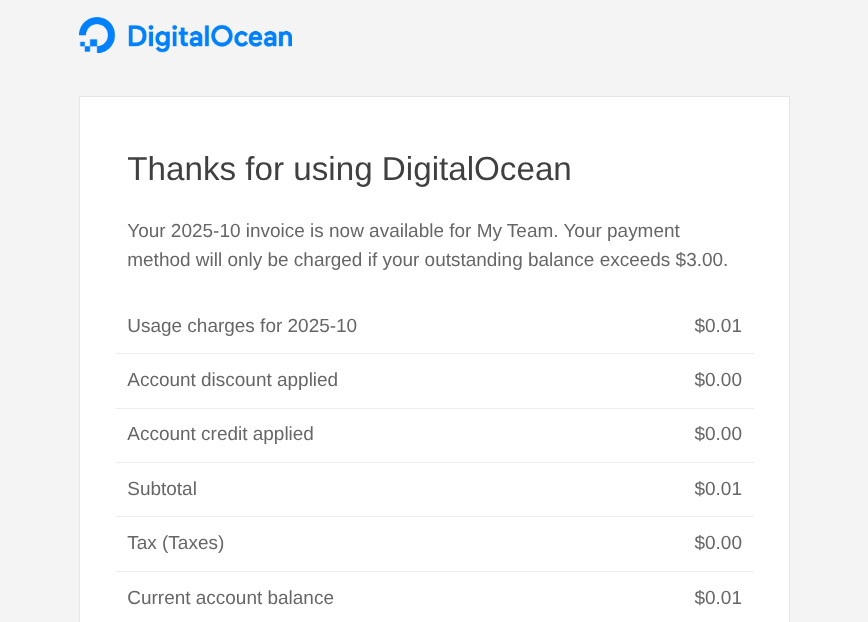
On Saturday, 25 October 2025, an email with the subject “Payment required: Your pre‑payment has been used” arrived in my inbox. It informed me that my prepaid credit was insufficient to cover the month’s usage and urged me to “make another payment or add an alternate payment method.”
There was just one catch: the outstanding balance was $0.01. I chuckled, and went on with my day only to receive the exact message two more times over the coming days. By the time Saturday rolled around, my inbox looked like this:
The inbox search screenshot above shows the cadence: identical “Payment required” messages on October 25th, 28th, and 31st, 2025, followed by an email on November 1, 2025, titled “Your 2025‑10 invoice is available.”
The invoice email (screenshot also above) contains a table that lists the usage charges for October as $0.01, notes that the payment method will only be charged if the balance exceeds $3.00, and invites me to “View Invoice.” Here’s what those other three messages look like:

My immediate reaction was a bit of a chuckle, but by the fourth email, I was more curious than anything: Why does an automated billing system send four emails about a 1-cent balance? DigitalOcean’s billing documentation notes that invoices are generated monthly. In my case, the system sent several “action required” emails, maybe because I don’t have a payment method saved? But in any case, I rarely use my personal DigitalOcean account beyond just quick tests:
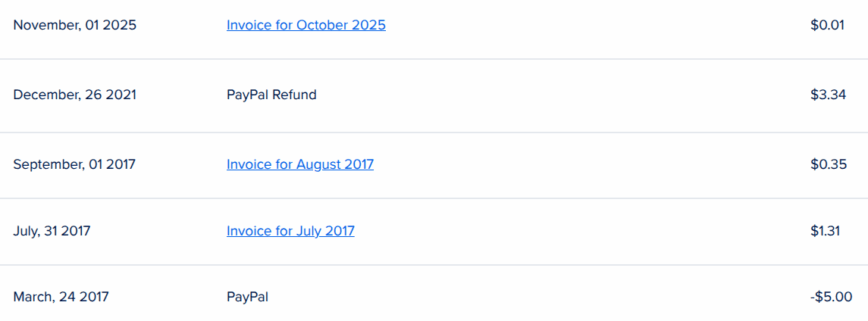
This experience of multiple emails for 1 cent owed, prompted me to think about the hidden costs of excessive email notifications and how we can design billing and alerting in a more thoughtful way.
The True Cost of an Email

Capgemini.com Infographic: Are you aware of your digital carbon footprint?
Email feels free because individuals don’t pay per message, but providers do. A 2025 breakdown of email marketing costs notes that the typical cost for a business to send emails is $1–$2 per thousand messages, translating to roughly $0.001–$0.002 per email. Amazon’s Simple Email Service charges $0.10 per 1,000 emails for outbound messages (sending or receiving) and a few cents per gigabyte for attachments.
This cost is likely less for DigitalOcean, with the three “Payment required” notices and one invoice with attachment costing the company at most between a tenth and two‑tenths of a cent to send. But multiply that by hundreds of thousands of customers, and it highlights how easy it is to use resources to clutter inboxes over microbalances.
The monetary cost is only part of the picture. Email has an environmental footprint because electricity powers servers, networks, and client devices. Researchers estimate that more than 306 billion emails were sent in 2021, and the total is expected to hit almost 400 billion this year, thanks to DigitalOcean. jk!!
According to Mike Berners‑Lee, a short text email can produce 0.2–0.3 g of CO₂, while a longer message with attachments can produce 17 g; an email blast to 100 people may generate 26 g or more. Email‑related emissions accounted for approximately 150 million tons of CO₂e in 2019. That’s about 0.3% of the world’s carbon footprint. But more importantly, about 25% added to users’ annoyance levels – Source: “Trust me bro!”
Notification fatigue and design principles
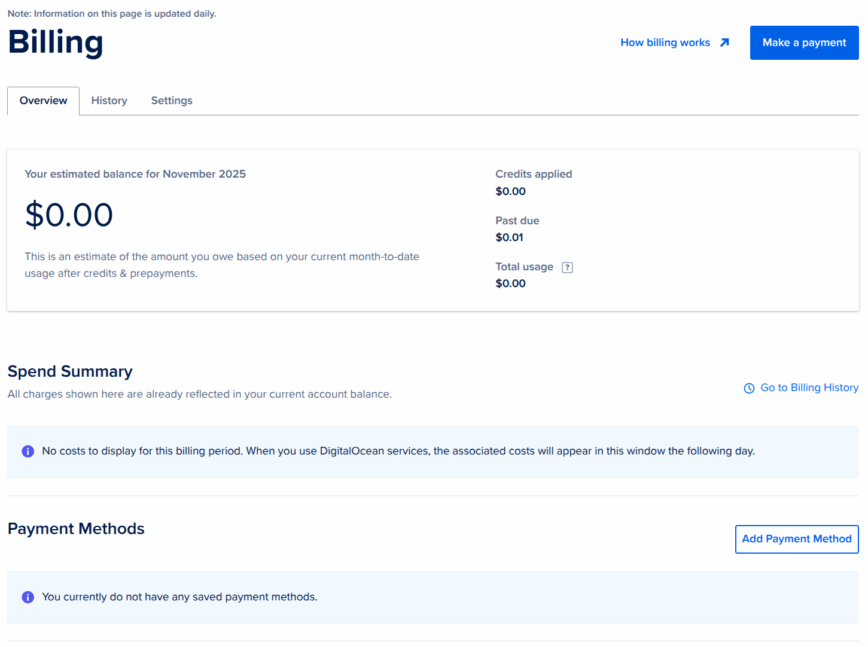
Would I have received that many emails if PayPal was saved to my account?
It isn’t just about costs or the environment. Usability tests consistently show that frequent alerts are one of the top user complaints. In fact, it’s been proven by Facebook and others that sending fewer notifications can be better for both engagement and retention.
Good notification design also recognizes levels of severity: high‑attention alerts (e.g., security breaches or failed payments) should prompt immediate action, while low‑attention messages (informational updates) can be bundled or deferred. Services like Slack, for example, adapt notification frequency automatically when channels become very active.
Looking at DigitalOcean’s billing reminders, it’s easy to see opportunities for improvement. A one‑cent balance does not warrant three emails + an invoice. The first message could have been informational (“heads up, your balance is low”), the second might wait until the balance crosses a predetermined threshold (say $1 or $3), and the third could be a month or 3 months later.
Alternatively, DigitalOcean could incorporate a small balance waiver similar to the one many credit card issuers use. Banks recognize that it’s not cost‑effective to chase pennies; they round down or apply a credit adjustment on the next statement. The same logic could help cloud providers reduce overhead and user frustration.
It’s not just DigitalOcean: micro‑balances happen everywhere
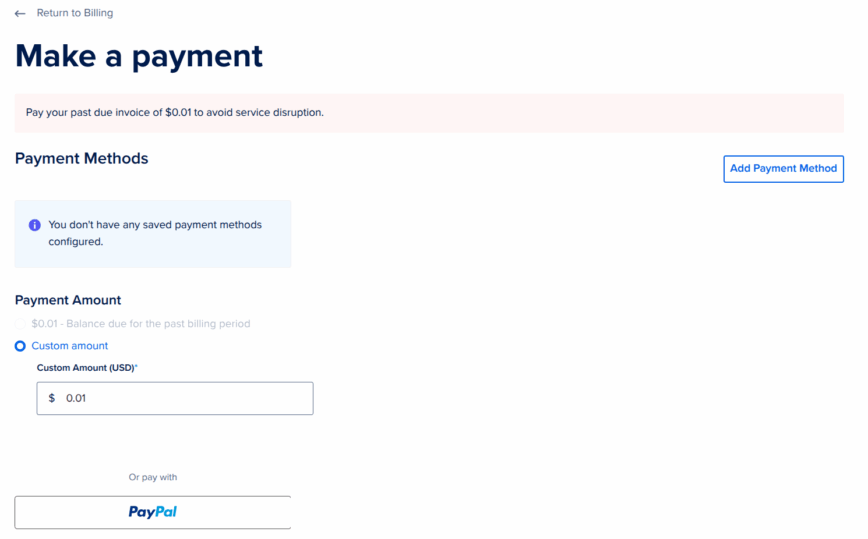
Would DigitalOcean really pull the plug for $0.01?
DigitalOcean isn’t alone in sending tiny bills. Back in 2013, an Optus customer in Australia posted on Whirlpool forums that a billing error left them with a one‑cent overdue notice after receiving a reimbursement. One commenter wrote that it would cost the company “more in personnel overheads to deal with this stupid billing error, than what it’s worth”, while another explained, “It’s an automated system, mate. Just relax.”
The moral of the story is that most companies rely on automated billing scripts, and without sensible thresholds, they’ll dutifully produce statements for even the most trivial amounts.
In practice, if you owe 99 cents or less, many companies apply a credit adjustment and report a zero balance. The banking industry has recognized that goodwill and efficiency outweigh the pennies left on the ledger. If major financial institutions can swallow a dollar, cloud platforms with higher margins can too.
What this taught me and how I’ve been guilty too
As someone who deploys systems and manages mail servers, I can’t throw stones without acknowledging my own missteps. Earlier this year, I built dewedda.com, a storm‑watch website for the Eastern Caribbean. Part of which was to send automatic email alerts to subscribers when storms approached islands within specific distances and directions.
In testing, everything looked great: the algorithm computed wind fields, adjusted for intensity, and tracked dozens of scenarios. But the first time a real storm approached, my code started hammering subscribers with unnecessary alerts. It didn’t account for storms that curved away or systems that were still unnamed, resulting in duplicates, so people kept receiving warnings even when there was no threat or duplicate emails. I had to scramble to adjust the logic.
The experience taught me humility and the importance of edge cases, and it makes me more sympathetic to DigitalOcean’s engineers. Building resilient billing and notification systems is complex. Edge cases arise when accounts straddle billing cycles, use promotional credits, or move between team and personal billing. Legacy code and third‑party integrations can behave unpredictably. What matters is how we learn from these events.
Conclusion (yes, I paid that one cent)
I paid the 1 cent balance owed to DigitalOcean. But who covers that transaction cost?
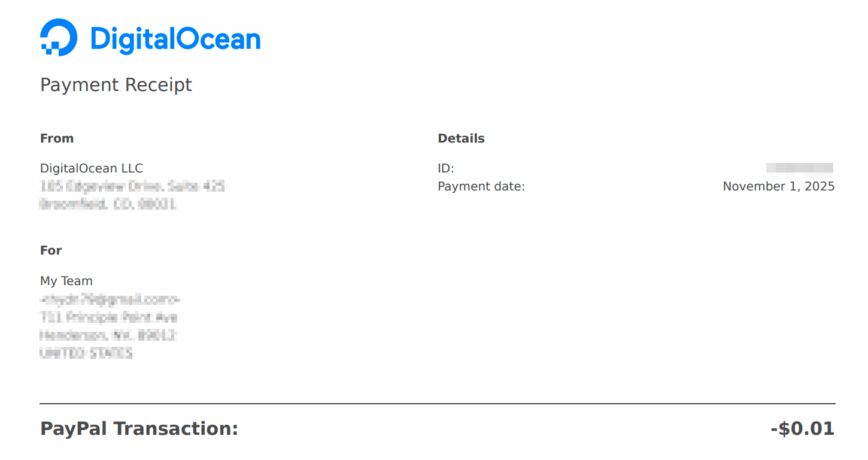
In the end, I did what any responsible business owner would do: I logged into my account and paid the one‑cent balance. Because, it would sit there for months, I only used a droplet for ~1 hour to test something. My personal DigitalOcean account goes mostly unused. So paying this invoice also means no recurring emails to pay my bill. Maybe that’s their plan? Ha!
I hope this article highlights the hidden inefficiencies that creep into automation, whether it’s cloud invoices, marketing emails, or storm alerts.
I still recommend DigitalOcean to friends and clients. They offer a great product at a fair price, with transparent billing. Being able to spin up a droplet in a few seconds makes life easy for Linux nerds like me. This one‑cent episode doesn’t change that; it simply underscores the value of thoughtful notification design. There are no affiliate links in this post either.
In summary, as repeatedly proven, sending fewer, more relevant notifications improves user satisfaction and retention. The environmental data also shows that unnecessary emails carry hidden costs, and financial industry practices demonstrate that forgiving tiny balances can be cheaper than collecting them.

I received two payment confirmation emails. :)
A bit of humor on a Saturday morning turned into a lesson for all of us on building better systems. And yes, just in case the automated script is listening, I can confirm that as of writing this, my DigitalOcean account balance is zero.

This is just the tip of the iceberg. (I hope the saying goes in English too?)
Years ago I got a reminder about 10 cents, by mail! No not email, paper mail.
Just the paper and the sending was more expensive than 10 cents
Update:
I’m not sure if it’s coincidental. Because I certainly have not requested a refund. But DigitalOcean issued a refund overnight, not for $0.01 but for $5.00:
In any case, I’m passing this along to a small project that I occasionally support: Beekeeping Community Development Zimbabwe
You can learn a bit more about this venture here. You can also find them mentioned in this PDF document: Farmer-Led Adaptation: Best Practice Case Studies.
Reminds me of 30 years ago when a local tax authority cashed my check for 6 cents more than they were supposed to. I mailed a letter (30 cents or more) demanding my 6 cents back. I received my letter back with 6 Pennies taped to it. They actually paid to mail that back to me.

In addition to the excellent points you made, retrieving an uncollected debt of $0.01 via PayPal Merchant Services (i.e. PayPal checkout on website) will result in a net loss of about $0.28 or $0.48 (with chargeback protection) according to PayPal Business Services website.
Transaction fees: 2.9% + $0.29 or 2.9% + $0.49 (including chargeback protection service)
They are, in some cases, multiplying their original loss x 2800 or 4800% with each successfully collected debt.